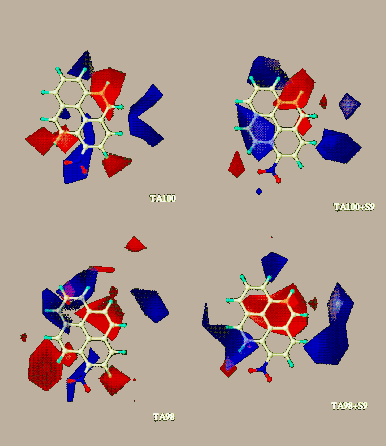
Meiyun Fan, Christine Byrd, Cesar M. Compadre, and R. Lilia Compadre
Mutagenicity in Salmonella Typhimurium TA98 and TA100 With and Without S9 Activation.
Department of Biopharmaceutical Sciences and Biomedical Visualization Center University of Arkansas for Medical Sciences, Little Rock, Arkansas, 72205 USA. E-mail: rlcompadre@life.uams.edu
Nitroaromatic compounds are ubiquitous environmental pollutants, and many nitroaromatics are potent mutagens and carcinogens. The mutagenicity of a comprehensive data set of heterogeneous nitroaromatics tested with Salmonella typhimurium TA98 and TA100 with and without S9 microsomal activation was analyzed using Molecular Field Analysis (CoMFA). The study of the quantitative structure-activity relationships (QSAR) of nitroaromatic mutagenicity in the S. typhimurium assay or "Ames" test is important because the mutagenic potency of these compounds is strongly associated with their carcinogenicity. Moreover, QSAR models help to summarize and organize information, provide insight into the molecular mechanisms of biological activity, and could be used to screen untested, new or not yet-synthesized compounds, to select those predicted more toxic for further research. The four CoMFA models developed agree with postulated mechanisms of mutagenicity, and explained over 70 % of the corresponding mutagenic variance. The standard deviation coefficient contours common in the four models included high electronic density regions equivalent to C4-C5 in the pyrene ring, and an electron deficient site equivalent to C6 in pyrene as illustrated in Figure 1.

These areas are associated with high mutagenicity. Steric contours indicated that increasing bulk perpendicular to the aromatic plane would decrease mutagenicity, but increasing the aromatic ring system along a region correspond ing to C6-C7 in 1-nitropyrene would increase mutagenicity.